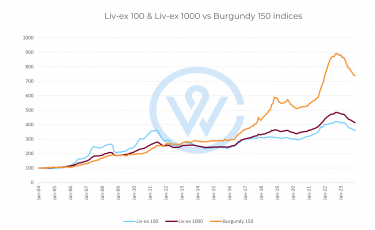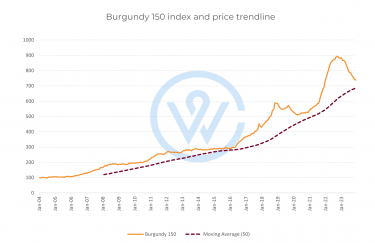History of Burgundy’s price performance
The following article is an extract from our Burgundy regional wine investment report.
- Burgundy is the region with the highest average bottle prices.
- It is the best-performing fine wine region, considerably outperforming industry benchmarks.
- This article analyses its historic performance, the drivers behind its success, and what this might meant for the future of the region.
Burgundy has earned an impressive reputation in the fine wine investment landscape. The region is the outright leader when it comes to average bottle prices and the long-term performance of its wines.
The Burgundy 150 index, which tracks the prices of the last ten vintages across 15 Burgundy brands, is the leading Liv-ex regional index, continually outperforming Bordeaux, Italy and Champagne. It is up over 650% since its inception.
Although the index only comprises a narrow pool of highly traded wines, it provides an indication of the direction of Burgundy prices. During its impressive rise, the index experienced only one significant drop of 15%, giving investors confidence that its punctuated equilibrium will continue.

Historic performance of Burgundy prices
The Liv-ex Burgundy 150 index doubled from early 2006 to mid/late 2008 — the first awakening of the Burgundy market as a new generation of wealthy consumers started to dominate the collectors’ market. This was at least in part driven by the volume of information available to them online from reviewers like Robert Parker and Allen Meadows and a greater focus on fine wine from the major auction houses.
After the 2008 financial crisis, Burgundy was somewhat left in the shadow. With the opening of the Chinese market, Bordeaux grew massively between 2008 and 2011. When Bordeaux fell from its 2011 peak, a new generation of investors flocked to Burgundy, seeking growth and breadth to their holdings.
From 2016 to late-2018, the value of the Burgundy 150 index doubled again. This can be attributed to growing liquidity in the sector and its recognition as a viable high-return investment. The region experienced a period of decline in 2019/2020, after a 15-year period without any significant downward movements. Some of this retreat has been related to profit taking and, later on, to the Covid-19 pandemic. Burgundy quickly made up for lost time in 2021 and 2022, with factors such as increased at-home consumption of fine wine, growing online trade, and rising liquidity contributing to its success. The index hit an all-time high in October 2022 at 909.4.
The market at large experienced another period of contraction in 2023, due to a combination of macroeconomic factors such as geopolitical conflicts, the lasting effects of the pandemic, high inflation and rising interest rates. Burgundy was the hardest hit region.
However, the overall direction of prices remains upwards as the trendline in the chart below shows. Such periods are advantageous times for Burgundy buyers who are usually able to find more stock at lower prices.

To find out more about the investment market for Burgundy wines, read the full report here.
Three reasons why the Brexit deal will prevent customers from paying more for their wine.
Ever since the UK voted to leave the European Union in 2016, trade talks and negotiations between the two sides had been full of uncertainty, posturing and brinkmanship which at times made it feel like a deal was unobtainable. So, the news that a trade deal – now ratified by the UK Parliament - had been struck on Christmas Eve last year was met with welcome relief across all industry sectors on both sides of the Channel and especially by those looking to invest in wine.
1. The costly VI-1 import documentation for UK and EU wines is no longer going to be introduced in July as previously planned. Taking its place will be a straightforward Wine Import Certificate which asks for basic producer and product information. This means far less admin and fees for wine importers, which in turn means no extra costs will be passed on to customers.
2. Crucially, wines will not have to undergo lab assessment for the new Wine Import Certificate. Submitting wines for lab analysis would have caused backlogs of wines which would have created frustrating shipment delays.
3. While UK wine importers are going to have to get to grips with new processes and forms over the coming months, this is just part of the anticipated bedding-in period which will become second nature as time goes on and as new processes are established.
With the previous uncertainty around Brexit having disappeared with the end of the transition period and with 2021 looking to mirror previous years of healthy returns for fine wine, contact us to speak to one of our advisors about creating your portfolio to invest in wine.
Sign up to our newsletter to keep in the know about market developments
Subscribe to our newsletter
T: UK +44 207 060 7500T: US +1 310 310 7610 | hello@winecap.com
Registered Office: WineCap Limited, Salisbury House, London, United Kingdom, EC2M 5SQ
WineCap Limited | Company No. 08480079 | VAT No. GB174 8533 80 | AWRS No. XCAW00000119418 | WOWGR: GBOG174853300
Copyright © 2025 WineCap Limited
T: UK +44 207 060 7500 | T: US +1 310 310 7610 | hello@winecap.com
Registered Office: WineCap Limited, Salisbury House, London, United Kingdom, EC2M 5SQ
WineCap Limited | Company No. 08480079 | VAT No. GB174 8533 80 | AWRS No. XCAW00000119418 | WOWGR: GBOG174853300
Copyright © 2025 WineCap Limited